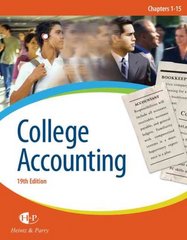Question
Huron Company produces a commercial cleaning compound known as Zoom. The direct materials and direct labour standards for one unit of Zoom follow: Standard Quantity
Huron Company produces a commercial cleaning compound known as Zoom. The direct materials and direct labour standards for one unit of Zoom follow:
Standard Quantity
or HoursStandard Price
or RateStandard
CostDirect materials4.40kilograms$2.20per kilogram$ 9.68Direct labour0.41hour$11.00per hour4.51Variable overhead0.41hour$1.80per hour0.74
The budgeted fixed overhead cost is $15,851 per month. The denominator activity level of the allocation base is 861 direct labour-hours.
During the most recent month, the following activity was recorded:a.9,100 kilograms of material were purchased at a cost of $2.22 per kilogram.b.All of the material purchased was used to produce 2,100 units of Zoom.c.A total of 850 hours of direct labour time was recorded at a total labour cost of 9,435.d.The variable overhead cost was $1,700, and the fixed overhead cost was $17,108.
Required:1.Compute the direct materials price and quantity variances for the month.(Indicate the effect of each variance by selecting "F" for favorable, "U" for unfavorable, and "None" for no effect (i.e., zero variance).)
2.Compute the direct labour rate and efficiency variances for the month.(Indicate the effect of each variance by selecting "F" for favorable, "U" for unfavorable, and "None" for no effect (i.e., zero variance).)
3.Compute the variable overhead spending and efficiency variances for the month.(Indicate the effect of each variance by selecting "F" for favorable, "U" for unfavorable, and "None" for no effect (i.e., zero variance). Round "Efficiency variance" to 2 decimal places.)
4.Compute the fixed overhead budget and the volume variances for the month.(Round intermediate calculations to the nearest whole dollar amount. Indicate the effect of each variance by selecting "F" for favorable, "U" for unfavorable, and "None" for no effect (i.e., zero variance).)
5.Compute the underapplied or overapplied overhead for the month.(Round intermediate calculations and round final answer to 2 decimal places. Indicate the effect of each variance by selecting "F" for favorable, "U" for unfavorable, and "None" for no effect (i.e., zero variance).)
Step by Step Solution
There are 3 Steps involved in it
Step: 1

Get Instant Access to Expert-Tailored Solutions
See step-by-step solutions with expert insights and AI powered tools for academic success
Step: 2

Step: 3

Ace Your Homework with AI
Get the answers you need in no time with our AI-driven, step-by-step assistance
Get Started


